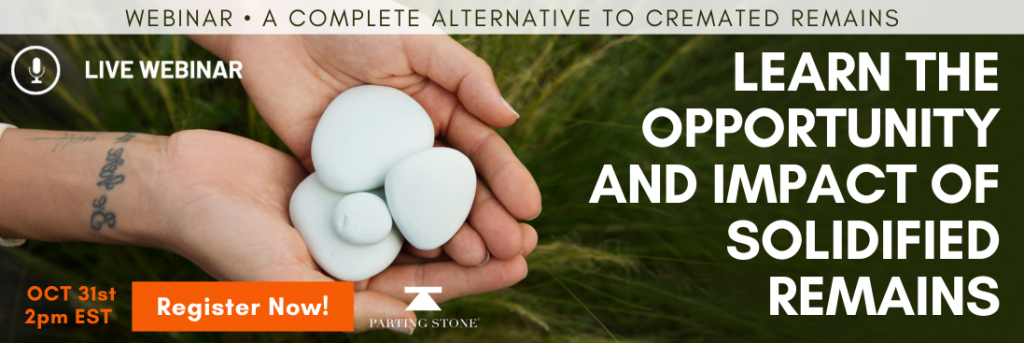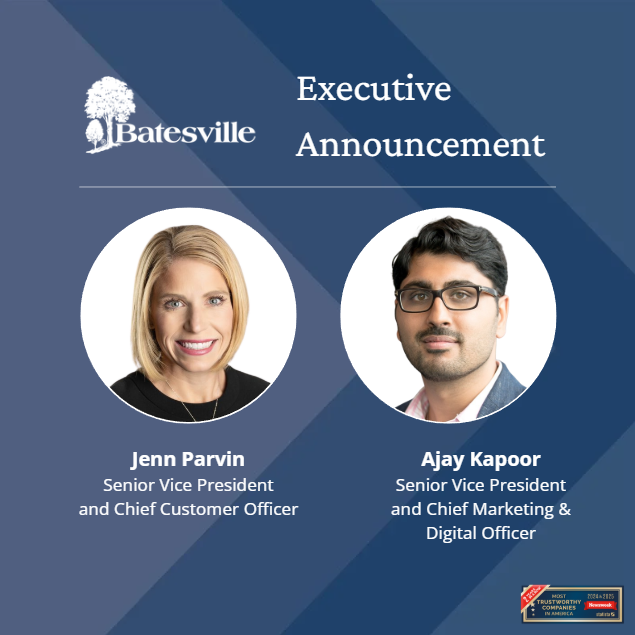Secrets to Successfully Sharing Parting Stone With the Families You Serve
Earlier this year, funeral director Lacee Green was surprised to learn from Parting Stone founder Justin Crowe that she was the top seller among the company’s many partners. That’s because to Lacee, solidified remains from Parting Stone aren’t something she “sells.” They are something she simply feels she has to share with the families she serves.
“I did not set out to do that,” says Green, who serves families in the Denver, Colorado area. “It’s just when I started here, I found such value in them. I started to see families’ experiences in their emotions and their feedback. And it just became natural for me to offer.”
Personal stories set the scene
Green loves the concept of Parting Stone: offering families the opportunity to transform the messy cremated remains of a loved one into smooth stones that they can hold, display, and share. She loved it so much that she entrusted the company with the remains of her beloved 14-year-old cat. That personal experience just added to her enthusiasm for and belief in Parting Stone.
Jill St. Laurent has a story similar to Green’s. A licensed funeral director who serves Legacy Funeral Group as Training and Development Coach, St. Laurent has introduced Parting Stone to many Legacy staff members. However, it wasn’t until last year that she came to realize the profound impact solidified remains can have on a family who has lost a loved one.
“I was able to send a portion of my grandfather’s cremated remains [to Parting Stone],” St. Laurent shares. “His stones have gone to six states and back to his farm in Nebraska. There’s a little piece of him everywhere because it continued his life story.”
Certainly, these personal encounters with Parting Stone have provided incredibly meaningful stories for St. Laurent and Green to share with families. Even though that won’t be the case for every deathcare professional who has the opportunity to share Parting Stone with families, these stories — and the approaches these directors have adopted to explain and promote the concept — can serve as an effective blueprint for successfully offering this unique service.
1. First impressions matter
As St. Laurent and Green explain specifically how they introduce Parting Stone during their interactions with families, both disclose that having Parting Stones on display is foundational.
“We strive to keep them on the arrangement tables so that it’s part of the conversation,” St. Laurent says, explaining that Parting Stone’s training team supplies partners with a complete kit of materials, including sample stones, to share with families.
Green says she, too, keeps solidified remains visible during arrangement meetings.
“I have two sets of stones in two different display table pieces,” she says, adding that she also has a Parting Stone testimonial video brochure from Parting Stone on hand, which she supplements with her own story.
2. Every time, to every family
Another key to Green’s success is that she tells every family about Parting Stone — even if they have selected a disposition other than cremation.
“I offer them to my burial/traditional casket families,” she says. “There are a lot of people with cremated remains sitting in their closets. I’ve had a couple of families I served when one of their parents died and they’d had the cremated remains of the other parent in an urn at home for 10 or 15 years; they brought both urns to me and I had both turned into stones for them. [I tell every family because] even if they’re not interested, they’re going to know somebody else. I’ve had a lot of referrals from those families.”
St. Laurent agrees.
“You never know who’s sitting across from you at the table,” she says. “And you never know who is influencing that decision maker at the table for other options and how we can impact the entire family.”
She speaks from experience, as she was prompted to send her grandfather’s remains to Parting Stone after getting a call from a cousin who learned of the company during Crowe’s appearance on Shark Tank — one week after their grandfather’s death.
“The next week he texted me and said, ‘What is this?’” she recalls. “I said, ‘We can offer that. My company offers it.’”

3. Educate yourself on the product and process
Despite the exposure Parting Stone received from the Shark Tank deal and the exponentially growing number of social media stories families are posting, there are still millions of people who have never heard about solidified remains. That’s why the educational component of the training St. Laurent provides to her firm’s directors is so important.
“That gives them the training and confidence to just have a conversation,” she says. “They feel confident that if a family asks about it, they know how to order it, how the process of solidification happens, and what to expect after the remains are shipped back. It gives them a better understanding [so that they aren’t just saying], ‘This is Parting Stone.’”
Top seller Green has provided similar advice to other directors in the Denver market when they call to ask her how she’s been so successful.
“I’ve asked those location leaders if I can come speak to their directors,” Green says, “because if you’re not comfortable introducing something to somebody because you don’t know about it, you’re just not going to talk about it, right? And I don’t feel that directors are talking about it because they don’t know how to introduce it.”
4. Introduce Parting Stone as the innovation it is
Once a director is familiar with Parting Stone, St. Laurent suggests they use some of the arrangement meeting time as an opportunity to pass that education along to the families.
“They don’t know what they don’t know,” she says. “They don’t know what’s out there until we say, ‘Can I have just five minutes of your time to tell you about some of the other options that weren’t’ around five or ten years ago?’”
During those conversations, St. Laurent explains that burial and cremation are no longer the only forms of disposition, and ashes are no longer the only form of cremated remains that can be returned to the family. She adds that asking questions of those folks around the table about what they and their other family members would like or need is important.

5. Know enough to share alternative solutions and benefits
Both St. Laurent and Green admit that not every family is going to automatically choose Parting Stone for their loved one’s remains. Green has had to overcome family members’ objections to the new idea of transforming ashes into solidified form plenty of times. To her, that’s an opportunity to propose new options.
“I share experiences of what other families have done with the stones, and I can see their wheels turning,” Green says. “I see them thinking. But some people may not be super hot on the stones. I tell them that’s ok, because they can send in all of the remains, or they can send just a portion of them, and keep the ash part to scatter. That’s the awesome, flexible part of Parting Stone.”
A director at one of the locations where St. Laurent trains asks an especially effective question of direct cremation families who want just that — cremation services only.
“They have found great success in saying, ‘Tell me what you’re going to do with Mom afterwards,’” she says. “They explain that there’s no amount of personalization you can do on an urn to make it as personal as solidified remains, which you can hold in your hand. This is not a disposition. This is not a keepsake. It’s not a fingerprint. It’s just Mom, in a different form.”
6. Anytime is a good time
Sometimes those initial conversations about Parting Stone are simply an opportunity to plant a seed of an idea that sprouts at a later date. Parting Stone also provides directors a wonderful reason to reach back out to cremation families years after they’ve received the cremated remains of their loved one.
“You can always go back and serve those families that have maybe taken their loved one home in the past years,” St. Laurent says. “It’s a good time to have a phone call with them just to say, ‘Just want to let you know we’re thinking of you. And you know, we do have a new option now.’ I feel like it’s our duty as an industry just to give the options.”
Green agrees.
“I am so thankful that this company is out there and that families have another option,” she adds. “There are so many people sitting with ashes at home. They can do something more meaningful. This is another avenue I can offer their family. And it’s brand new. And they’re going to love it. I’ve not had one family come back and tell me they did not like the stones.”
Want to learn more about solidified remains? Sign up for their informational webinar on Halloween at 2pm EST to learn how other funeral homes are growing their business with Parting Stone.





